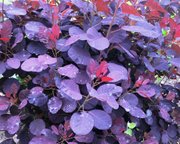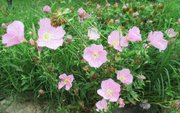Q I feed the birds year round, have seven hummingbird feeders out and love watching them. I see pictures of hummers lined up around the feeder, but these guys fight and only one at a time will feed. Is there a secret to getting more than one hummer on the feeder at a time?
A Hummingbirds are not social beings, tending to live fairly solitary lives. Males are also very territorial and protect "their" space, trying to keep other males out. While they will share with females more willingly, your key is to have up as many feeders as you can handle and let them work it out.
Q We have a more than 70-year-old sweet gum tree that has begun dropping its leaves. The leaves are yellow mixed with green. Usually leaves do not begin falling until August. Other trees in the neighborhood are OK. What's going on?
A There are a number of things that can cause trees to drop a few leaves -- insects, diseases, storm damage or high winds. It could be something as simple as the possibility that while we were getting tons of rain the tree was in a growing phase, and now that we have finally gotten hot and dry, it is sloughing off some extra foliage. If it's losing a few leaves here and there, that is not something we worry about. If the entire tree defoliates, that can be a different concern. Falling leaves are less often an indicator that a tree is dying; a more likely indicator would be dying leaves that dry and remain attached to the tree. If you are concerned, take some of the leaves along with a photo of the overall tree to your local county extension office. They can send samples to the University of Arkansas Division of Agriculture's Cooperative Extension Service disease diagnostic lab. Unfortunately, with large trees, if they truly are dying, there is little we can do to reverse the problem. Keeping your trees healthy with regular watering when dry can help.
Q This flower [the reader sent a photo] was transplanted from the wild several years ago. It has come up each year. I would like to identify so I could get seeds. Any idea what it is?
A Be careful what you wish for. Showy evening primrose (Oenothera speciosa) is a lovely wildflower, but it can get a bit happy in good soil. It freely reseeds itself and a few plants can quickly turn into more than you want. If you do plant more, learn to recognize it in the seedling state so you'll be able to contain it.
Q Attached is a pic of our new driveway going across the front of our home in Edgemont. Could you suggest a ground cover to plant between the tracks? This area gets full afternoon sun and is on the south side of the house. I know we will need to add soil after cleaning out the old gravel.
A This is going to be a hot, dry location. Will you be able to water? Some drought-tolerant, ground-hugging plants to consider are thyme, one of the sedums and prostrate rosemary. For a taller plant, you could use daylilies, a low growing ornamental grass or liriope (for once I would recommend the running form, Liriope spicata, since your space is contained on all sides).
Q I noticed a beautiful tree in our neighborhood in Conway this year [the reader sent in a photo]. Can you identify it so I don't have to go knock on a stranger's door?
A The tree is a purple smoke tree; Cotinus is the genus. Smoke trees typically have green foliage or purple foliage, but a new one, "Golden Spirit," has yellow foliage. These are normally grown as large bushes or small trees. They produce tiny flower clusters in early summer, and the stalks of the fruit clusters are covered with hairs that give the plant a "smoky" appearance.
Janet B. Carson is a horticulture specialist for the University of Arkansas Cooperative Extension Service. Write to her at 2301 S. University Ave., Little Rock, Ark. 72204 or email her at
HomeStyle on 06/20/2015



